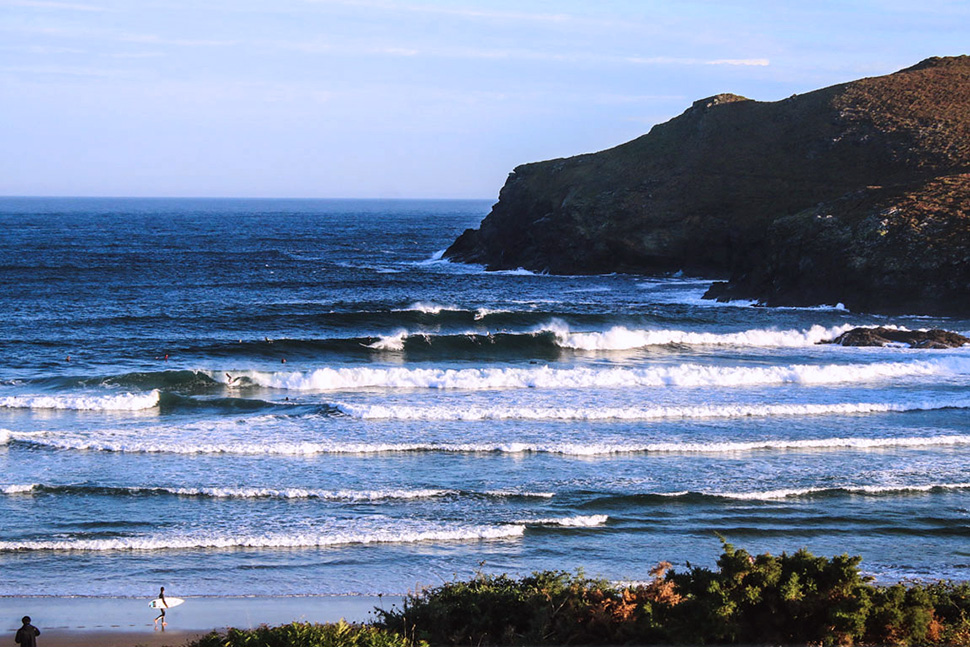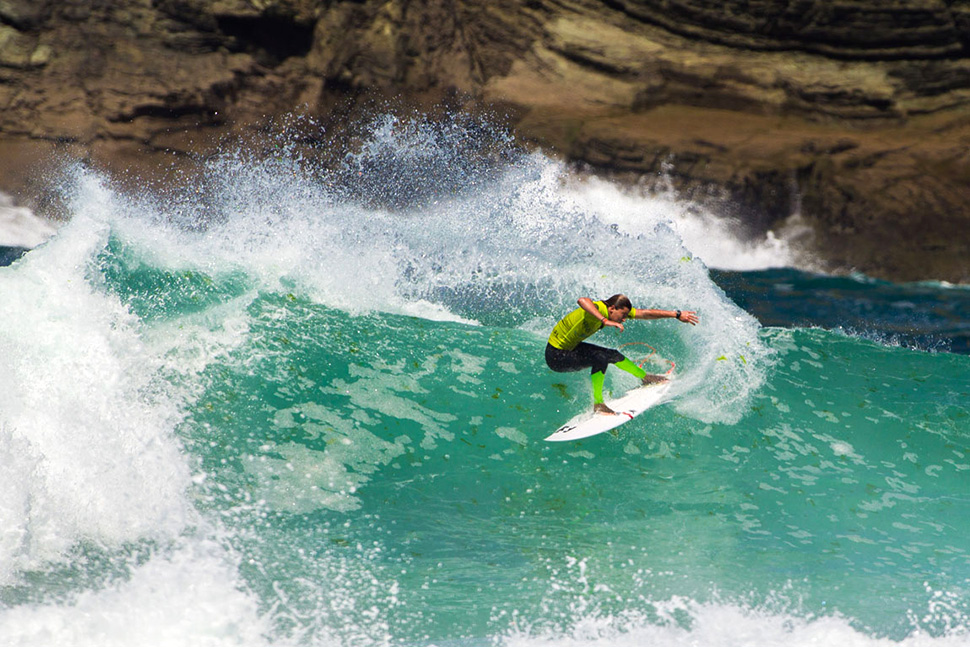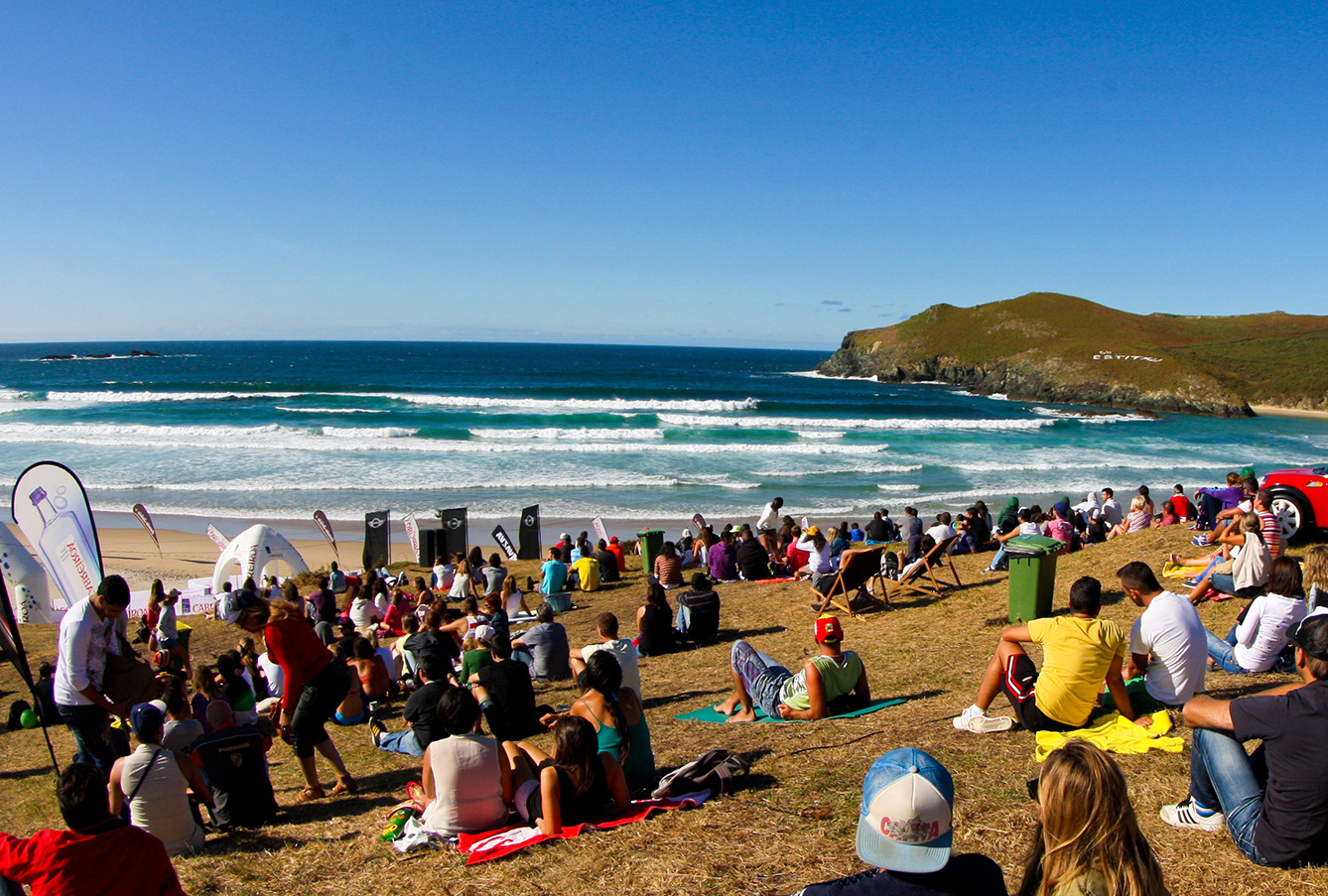Pantín / Spain – Surf – Coruña – Valdoviño – Galicia

 Surfergalaxy
Surfergalaxy 
| Wave | Beachbreak |
| Ola | Playa |
| Wind | S - SE |
| Tide | All |
| Marea | Todas |
| Swell | W - NW |
| Bottom | Sand |
| Fondo | Arena |
| Time of year | All year round |
| Época del año | Todo el año |
The northern orientation of Pantín together with the close proximity of Campelo Beach means that the swell enters more directly and with bigger waves. It’s one of the most consistent beaches in Galicia as the geomorphology of the cliffs that are enclosed in the horseshoe shaped bay forces the powerful waves towards its sandbanks. This protection from the cliffs also allows it to maintain the same flow of currents and the dynamics of the sandbanks don’t change. A good wetsuit is important in Galicia as the water is cold all year round, 4 mm is a safe bet but during the summer some use 3 mm, sometimes even 2 mm. The exposure of this spot to the strong winter storms from December to March means there are surf conditions most days.
With regards to the optimal conditions, the best time is often when the better weather begins in the spring and summer until September and October when it has the best conditions of the year. The swell normally enters from the NW, W and it benefits from the cliffs which protect it from the dominant NW winds which ruin the surf at most of the nearby beaches. The best conditions are between one and two metres with a low to mid rising tide, although there are good waves with all tides, and the best wind component is S, SE being ideal.
Surfable waves of up to five metres occasionally break at Pantín, making it the spot which holds the biggest size in Galicia and in addition, you can enter more safely thanks to the canals to the right of the sand. Pantín doesn’t need too much power as it receives a lot of swell, it’s normal to surf waves of over two metres, something that the great Galician surfers are used to and which you can find nearly all year round at Pantín.
There are various peaks at Pantín thanks to its size, however the legendary peak where the locals usually surf is the one that breaks at the right side of the beach, a very consistent right that breaks over a permanent sandbank and is the best quality wave on the whole beach which holds its size with any tide. There is also a good left but it’s more changeable and less consistent than the right. On the left of the beach there are other peaks, such as Marnela, which are better with low tide. To get good waves at this part of the beach you need low tide and quite a lot of W or NW swell, however, it’s an area with many varied peaks for all tastes and levels. Not many people go there, not even the locals, as when it breaks they prefer the other options at the nearby beaches.
There are a lot of currents at Pantín so you should be extremely cautious. There are two canals to go in from, one is right by the small island on the right of the beach and there is a central canal between the main peak where the Pantín Classic is held and the left side of the beach. If the conditions are hard, be patient when you are paddling out. Sometimes it’s better to catch a wave out and go back in using the canal.
La orientación al norte hace que Pantín junto con la cercana playa de Campelo sea por donde entra el oleaje más directamente y por tanto donde entran olas con mayor tamaño, al mismo tiempo la geomorfología de los acantilados que la encierran en una bahía con forma de herradura hace que la fuerza de las olas se concentre hacia sus bancos de arena, es por tanto una de las playas con más consistencia de Galicia. Esta protección de los acantilados que la bordean también permite que se mantenga siempre el mismo flujo de corrientes y que los bancos de arena de Pantín no varíen su dinámica. En Galicia es importante traer un buen traje de neopreno ya que a pesar de la latitud el agua esta fría durante todo el año, un 4 mm es una apuesta segura, aunque en verano algunos entren con 3 mm incluso 2 mm. La exposición de este lugar a los fuertes temporales de invierno desde diciembre a marzo hace que las condiciones sean duras para entrar al agua la mayoría de días.
En cuanto a condiciones óptimas la mejor temporada suele ser conforme va acercándose el buen tiempo, es decir primavera y verano hasta los meses de septiembre y octubre cuando se dan las mejores condiciones del año. El mar en Pantin normalmente entra desde el NW, W beneficiándose de la protección de los acantilados a los vientos dominantes del NW que estropean la mayoría de playas cercanas. Las mejores condiciones son entre metro y dos metros, la marea subiendo de baja a media, aunque haya buenas olas con todas las mareas, el mejor viento es de componente S y el SE es ideal.
En Pantín en ocasiones rompen olas surfeables de hasta 5 metros, por tanto la que más tamaño aguanta de Galicia y que además gracias a los canales situados a la derecha del arenal se puede entrar con mayor seguridad. Podemos decir que Pantin es una playa que no necesita que entre demasiada fuerza porque recibe mucho mar, siendo usual surfear olas de más de dos metros que acostumbran a los buenos surfistas gallegos a coger olas grandes que en Pantín hay durante casi todo el año.
En Pantín por su extensión hay varios picos, sin embargo el mítico pico de Pantín y donde suelen surfear los locales es el que rompe a la derecha de la playa, allí sobre un perenne banco de arena rompe una derecha muy consistente que es la ola de más calidad de toda la playa, esta derecha aguanta tamaño y cualquier marea. También sale una buena izquierda pero esta es más cambiante y menos consistente que la derecha. A la izquierda de la playa se disponen también otros picos como por ejemplo el conocido como Marnela, mejor en marea baja. Las condiciones para que haya buenas olas aquí son marea baja y bastante marejada del oeste o noroeste. Esta zona se caracteriza por ser una zona de muchos picos y variados para todos los gustos y niveles. Es un spot poco frecuentado incluso por locales, ya que a cuando rompe prefieren otras opciones en playas cercanas.
En Pantín hay muchas corrientes y debes extremar la precaución. Para entrar existen dos canales, uno situado pegado al islote de la derecha de la playa y un canal central entre el pico principal donde se celebra el Pantin Classic y el margen izquierdo de la playa. Si las condiciones son duras ten paciencia remando. A veces es mejor coger una ola salir y volver a entrar por el canal.

Pantín is one of the most well-known Spanish spots. Located in Galicia, it stands out for having good quality and consistent waves throughout the whole year. It’s like a wave factory and this is exactly why it’s called the Pantín factory. It’s been forty years since photos were taken of the first ever surfer at Pantín, the legendary Galician Carlos Bremón. Along with him, the other pioneer was Vicente Irisarri, considered as the founder of the Pantín Classic which brought the spot international recognition. The Pantín Classic is currently, since the WCT removed Mundaka from the tour, the most important international surf event in Spain. It has seen many of the world’s best surfers as it’s been a stop of the WQS circuit for years, of which 2014 saw the celebration of the 27th edition. The success of this event isn’t just down to the quality of the waves or the beauty of the place, but because the dates of the event fall in the summer and this brings a huge amount of spectators. Thanks to the natural amphitheatre which offers grassy stadium like stands, you can sit and enjoy the excellent views, not only of the competition but of the other activities which are also organised on the beach, for example surf baptisms for kids that want to experience the world of waves.
Pantín is an especially beautiful place, with pure white sand and extremely clean waters, a place that has good transport links nowadays and is easily accessible despite being surrounded by vegetation rich cliffs. There are large parking areas with wooden walkways to the sand, showers that work all year round and some of the best lifeguards in the area on patrol during the summer, many of which are also surfers who know the local spots well. Other options are Valdoviño to the west, a very large and exposed sandy beach with a multitude of peaks. Just one minute to the east of Pantín is Baleo Beach. It’s a quiet beach as it is so close to Pantín and is half hidden, however, it can occasionally bring nice surprises. When Pantín is big, you have the option to surf at Cedeira or at the sandy Villarube Beach, a beach which is very good quality at low tide but it isn’t easy to get to and only the people that know the area know when it breaks well.
Pantín Beach is an hour and a half away from the international airport in the important city Santiago de Compostela and just 15 kilometres away from the Ferrol estuary and port. Finally, it has to be mentioned that Pantín has a good position, nestled between Valdoviño (4km) y Cedeira (10km, villages which you should also bear in mind because they host many other good quality spots, and depending on the swell direction and wind, there will always be somewhere with surfable conditions. Without doubt, this area in the north west corner of Spain is, due to its exposure and the amount, variety and consistency of its spots, one of the best, not only in Europe but also increasingly in the world.
Pantín es uno de los spots de España y sin duda de Galicia más reconocidos a nivel mundial, un spot que destaca por la consistencia y la calidad de las olas durante todo el año, Pantín es como una fabrica de olas que precisamente por ello es llamada la factoría de Pantín. Cuarenta años hace desde la primera vez que la playa de Pantín fue surfeada, el protagonista de aquel primer baño solitario del que son testigos unas increíbles fotos fue el mítico surfista gallego Carlos Bremón. Junto a él también hay que destacar a otro pionero de Pantín, el querido Vicente Irisarri, considerado fundador del “Pantín Classic” que ha hecho que este lugar sea hoy reconocido a nivel internacional.
Actualmente “Pantín Classic” desde que se suprimió la prueba del WCT en Mundaka, es el evento de surf internacional más importantes de España. En 2014 ha celebrado su 27 edición, es por ello desde hace años una parada obligatoria del circuito WQS, prueba por la que han pasado los mejores surfistas del mundo. El éxito de este evento no solo reside en la belleza del lugar y la calidad de las olas, sino que al celebrarse en fechas de verano atrae una enorme cantidad de público, el cual gracias a la disposición del relieve puede situarse como en un anfiteatro natural similar a las gradas de un estadio con césped. Desde allí puede disfrutarse de unas excelentes vistas y no solo de la competición sino también de una gran cantidad de actividades complementarias que allí mismo se realizan, por ejemplo, bautismos de surf para todas los niños que quieren empezar en el mundo de las olas.
Pantín es un lugar de especial belleza, la arena es totalmente blanca y las aguas son extremadamente limpias, un lugar que a pesar de estar rodeado de verdes acantilados esta hoy bien comunicado y posee un fácil acceso. Cuenta con amplios aparcamientos, pasarelas de madera hasta la arena, dispone de duchas todo el año y en temporada algunos de los mejores socorristas de la zona, alguno de ellos también son surfistas y conocen muy bien tanto éste como el resto de spots de la zona. Otras opciones cercanas son a 5 minutos al oeste Valdoviño, un muy extenso y expuesto arenal con multitud de picos. A solo un minuto de Pantín al este se encuentra la playa de Baleo una playa que está medio escondida y de poca afluencia por la cercanía a Pantín, que sin embargo en ocasiones puede ofrecer muy gratas sorpresas. Cuando Pantín esta grande tienes la opción de surfear en Cedeira, o en el arenal de Villarube, este playa tiene mucha calidad con marea baja pero es un spot alternativo al que no es facil llegar y que solo los conocedores de la zona saben cuando rompe bien.
La playa de Pantín se sitúa a una hora y media en coche del Aeropuerto internacional de la importante ciudad de Santiago de Compostela, muy cerca a 15 km se encuentra la gran ría y ciudad portuaria de Ferrol. Y por último, decir que Pantín esta enclavada estrategicamente entre los pueblos de Valdoviño (4km) y Cedeira (10km, localidades que hay que tener en cuenta porque albergan otros muchos spots de gran calidad, que hacen que según la dirección del swell y el viento siempre exista un lugar con buenas condiciones para entrar al agua. Sin duda esta zona de la esquina noroeste de España es por su exposición, cantidad, variedad y la consistencia de sus spots, una de los mejores no solo de Europa sino también del mundo.

This region is closely linked with the Cantabrian Sea and has witnessed Galicia’s ancient history. It’s a big tourist attraction where you’ll find great historical heritage accompanied by spectacular scenery of the sea and mountains, huge undeveloped beaches, the Atlantic forests which are the most conserved in Europe, and the highest cliffs in Europe. You should visit San Andrés de Teixido, a small village 140 metres above sea level, located in the only place where the mountainsides allowed it to be built. It has extraordinary natural beauty and is closely linked to the famous sanctuary of the same name, a place where thousands of pilgrims go every year.
The A Capelada mountain range is near to San Andrés de Teixido. The cliffs soar 613 metres above sea level and descend directly from Herbeira to the Atlantic Ocean facing the powerful waves. It’s common to see wild horses on the road that crosses the mountains. Fragas Do Eume is considered as one of the Iberian forest jewels, it forms the most important surviving example of indigenous forest on the Galician coastline and is home to rare species that have international botanical fame. The oak forests dominate most of the territory and have survived human intervention since Neolithic times. It’s worth visiting the Doniños Lake that’s set deep in the valley and is well-known because of the quality of the waves at Doniños Beach. The lake is surrounded by large dunes and is a natural park that’s a well-reserved habitat for numerous bird species.
Esta es una comarca en estrecha relación con el mar Cantábrico y testigo de la historia más ancestral de Galicia, siendo un destino turístico de enorme atractivo, donde podremos encontrar un gran patrimonio histórico acompañado de espectaculares paisajes de mar y montaña, enormes playas todavía salvajes, el bosque atlántico costero mejor conservado de Europa o los acantilados más altos de la Europa continental. Visita obligada es acudir a San Andrés de Teixido, una aldea a 140 metros sobre el nivel del mar, ubicada en el único lugar en donde las laderas de las montañas permitieron su construcción, es un enclave de extraordinaria belleza natural y estrechamente ligado a su famoso santuario del mismo nombre, un lugar donde cada año acuden miles de peregrinos.
Cerca de San Andrés de Teixido se encuentra la sierra de A Capelada que desciende directamente desde la garita de Herbeira hasta las aguas del Océano Atlántico, en una sucesión de acantilados que se abren al intenso oleaje, con 613 metros de altura sobre el nivel del mar. Es muy frecuente ver caballos en estado salvaje en la carretera que atraviesa la Sierra. Por otro lado, Fragas Do Eume es considerada como una de las joyas forestales ibéricas y constituyen el más importante ejemplo superviviente de bosque autóctono sobre la franja litoral de Galicia. En él habitan especies de gran singularidad que le han otorgado fama botánica internacional. Los bosques de robles, que aquí llaman “fragas”, dominan la mayor parte de este territorio y han sobrevivido a la intervención humana desde el neolítico. Con tiempo merece la pena visitar El lago de Doniños, emplazado en un profundo valle comunicado con la famosa playa de Doniños, allí el lago se rodea de un amplio complejo dunar, paraje natural muy bien conservado y hábitat de numerosas especies de aves.